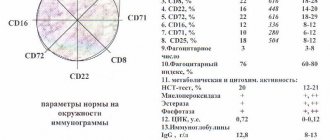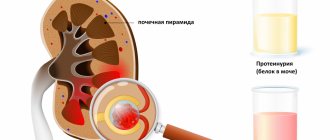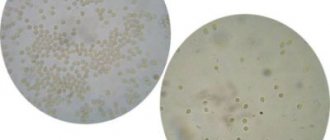Detailed description of the study
The study reveals hypersensitivity to 20 common respiratory allergens. The RIDA technique is a screening method with low specificity but fairly high sensitivity. To conduct the study, allergen extracts are used, each of which contains several allergenic components.
The analysis reveals the presence of hypersensitivity to each of the 20 most common respiratory allergens. The RIDA immunoblot contains:
- Derm mite. pteronyssinus;
- Derm mite. farinae;
- alder pollen;
- birch pollen;
- hazel pollen;
- oak pollen;
- mixed grass pollen;
- rye pollen;
- wormwood pollen;
- plantain pollen;
- cat feather;
- horse hair;
- dog's fur;
- guinea pig fur;
- hamster fur;
- rabbit fur;
- Penicillium notatum;
- Cladosporium herbarum;
- Aspergillus fumigatus;
- Alternaria alternata.
Respiratory allergens cause pathologies of the respiratory system, which are accompanied by discharge from the nose (less often from the eyes), itching, difficulty breathing, and cough. Bronchial asthma is especially dangerous, causing obstruction and even death. Diagnosis is made by detecting specific IgE antibodies in the blood. Their concentration determines the degree of sensitization to a particular allergen.
Source
Respiratory allergy complex RIDA-screen No. 2, IgE
Respiratory allergies include allergic rhinitis and bronchial asthma, which are widespread throughout the world. According to WHO, from 10 to 25% of the population suffers from allergic rhinitis and rhinoconjunctivitis, while 10-40% of them are diagnosed with asthma.
Allergic rhinitis itself is not very dangerous, but it significantly reduces the patient’s quality of life. Exacerbations are accompanied by severe nasal congestion, runny nose, sneezing, itching, lacrimation, and often inflammation and itching in the eyes. The most frequent exacerbations of rhinitis are during the flowering season of plants - from early spring to mid-autumn.
Bronchial asthma is much more dangerous; it greatly impairs the quality of life, and the patient must constantly take medications to control attacks. In asthma, as a result of an overreaction of the immune system, the reactivity of the bronchi increases, which leads to their spasm and temporary difficulty in exhaling - this is accompanied by wheezing, shortness of breath, coughing and suffocation and can lead to death if the attack is not stopped. The patient's condition can worsen not only upon contact with the allergen, but also under the influence of factors such as smoking, cold air, physical activity, hormonal changes, taking medications, and infectious diseases.
Sensitization to inhaled allergens can lead to allergic rhinitis and bronchial asthma.
These include:
- house dust mites (Derm. Pteronyssinus and Derm. farinae)
- alder (pollen)
- birch (pollen)
- hazel (pollen)
- oak (pollen)
- mixture of herbs (pollen: rye, timothy, fescue, ryegrass, fragrant spikelet, awnless brome, creeping wheatgrass, hedgehog grass, chaff, foxtail, buffalo, pigweed)
- wormwood (pollen)
- plantain (pollen)
- cat (epithelium)
- horse (epithelium)
- dog (epithelium)
- guinea pig (epithelium)
- hamster (epithelium)
- rabbit (epithelium)
- molds (Penicillium notatum, Cladospor.herbarum, Aspergillus fumigatus, Alternaria alternate).
For timely diagnosis of allergies, special laboratory complexes are used, such as the RIDA-respiratory allergy complex. This method is convenient in that it allows one test to identify sensitivity to all major respiratory allergens at once.
In what cases is research usually prescribed?
The RIDA respiratory panel is prescribed when examining patients with suspected allergic rhinitis or bronchial asthma in the presence of symptoms such as nasal congestion and itching, runny nose, sneezing, redness and itching in the eyes, cough, shortness of breath, wheezing in the lungs and suffocation, in especially if the patient or his relatives associate these manifestations with recent contact with any allergen.
The allergy complex is also prescribed by a doctor when managing patients with respiratory forms of allergy, including for making a decision on performing ASIT.
What exactly is determined during the analysis process?
During the study of the respiratory RIDA panel, the concentration of specific immunoglobulins of the IgE class is determined for each allergen from the panel list.
What do the test results mean?
An increased level of IgE to a certain allergen means the presence of sensitization to it and the likelihood of developing an allergic reaction when encountering the allergen again.
Test deadlines.
Usually the result can be obtained within 4-5 days.
How to prepare for the analysis?
You can donate blood at any time, three hours after eating or later.
Detailed description of the study
The study reveals hypersensitivity to 20 common respiratory allergens. The RIDA technique is a screening method with low specificity but fairly high sensitivity. To conduct the study, allergen extracts are used, each of which contains several allergenic components.
The analysis reveals the presence of hypersensitivity to each of the 20 most common respiratory allergens. The RIDA immunoblot contains:
- Derm mite. pteronyssinus;
- Derm mite. farinae;
- alder pollen;
- birch pollen;
- hazel pollen;
- oak pollen;
- mixed grass pollen;
- rye pollen;
- wormwood pollen;
- plantain pollen;
- cat feather;
- horse hair;
- dog's fur;
- guinea pig fur;
- hamster fur;
- rabbit fur;
- Penicillium notatum;
- Cladosporium herbarum;
- Aspergillus fumigatus;
- Alternaria alternata.
Respiratory allergens cause pathologies of the respiratory system, which are accompanied by discharge from the nose (less often from the eyes), itching, difficulty breathing, and cough. Bronchial asthma is especially dangerous, causing obstruction and even death. Diagnosis is made by detecting specific IgE antibodies in the blood. Their concentration determines the degree of sensitization to a particular allergen.
Source
Allergy panel No. 2 Respiratory, IgE
The panel of common household respiratory allergens is intended for a screening examination to identify significant allergens when allergies associated with respiratory (inhaled) allergens are suspected.
Indications for use
- Suspicion of an allergic disease.
- High levels of immunoglobulin E (IgE).
Preparing for analysis
- It is recommended to donate blood for testing on an empty stomach; you can only drink water.
- At least 8 hours must pass since the last meal.
- Blood sampling should be done before starting medications (if possible) or no earlier than 1-2 weeks after stopping them. If it is impossible to discontinue medications, the referral for the study must indicate which medications the patient is receiving and in what doses.
- The day before taking blood, limit fatty and fried foods, do not drink alcohol, and avoid heavy physical activity.
Respiratory allergens panel
- house dust (Derm. Pteronyssinus mite),
- house dust (Derm. Farinae mite),
- alder - pollen;
- birch - pollen;
- hazel - pollen,
- oak - pollen,
- mixture of herbs (rye (Secale cereale); meadow timothy (Phleum pratense); meadow fescue (Festuca elatior = pratensis); tall ryegrass (Arrhenaterum elatius); fragrant spikelet (Anthoxanthum odoratum); awnless brome (Bromus inermis); cocksfoot ( Dactylis glomerata); chaff (Lolium perrene); meadow foxtail (Alopecurus pratensis); woolly milkweed (Holcus lanatus); pigtail (Cynodon dactylon) - pollen
- rye - pollen;
- wormwood - pollen,
- plantain - pollen,
- cat - epithelium and hair;
- horse - epithelium and wool;
- dog - epithelium and hair,
- guinea pig,
- hamster,
- rabbit,
- Fungus Penicillium notatum,
- Fungus Cladospor Herbarum,
- Fungus Aspergilius fumigatus,
- Fungus Alternaria Alternata
General information
An allergy is an acute reaction of the body's immune system to normally harmless substances. Allergy symptoms can occur in different parts of the body, last from a few minutes to several days, and vary widely in severity.
Allergies can occur to the fur of certain animal species, various foods, dust, medications, chemicals, insect bites and pollen. Substances that cause allergies are called allergens. In some cases, allergic reactions are so mild that you may not even know you have an allergy at all.
Interpretation of results:
| Class | Concentration of specific IgE, IU/ml | Interpretation of the result |
| 0 | Negative - NORMAL | |
| 1 | 0,35 — 0,69 | Ambiguous, often without clinical manifestations |
| 2 | 0,70 — 3,49 | Weakly positive |
| 3 | 3,50 — 17,49 | Positive, with pronounced clinical manifestations |
| 4 | 17,50 – 49.99 | |
| 5 | 50.00 — 99,99 | |
| 6 | > 100 |
Reference values:
0
Level up:
1. allergic diseases; 2. sensitization to the allergen without clinical manifestations; 3. manifestation of cross-reactivity with another allergen.
Interpretation of research results
Interpretation of test results is for informational purposes only, is not a diagnosis and does not replace medical advice. Reference values may differ from those indicated depending on the equipment used, the actual values will be indicated on the results form.
Detailed description of the study
The study reveals hypersensitivity to 20 common respiratory allergens. The RIDA technique is a screening method with low specificity but fairly high sensitivity. To conduct the study, allergen extracts are used, each of which contains several allergenic components.
The analysis reveals the presence of hypersensitivity to each of the 20 most common respiratory allergens. The RIDA immunoblot contains:
- Derm mite. pteronyssinus;
- Derm mite. farinae;
- alder pollen;
- birch pollen;
- hazel pollen;
- oak pollen;
- mixed grass pollen;
- rye pollen;
- wormwood pollen;
- plantain pollen;
- cat feather;
- horse hair;
- dog's fur;
- guinea pig fur;
- hamster fur;
- rabbit fur;
- Penicillium notatum;
- Cladosporium herbarum;
- Aspergillus fumigatus;
- Alternaria alternata.
Detailed description of the study
The study reveals hypersensitivity to 20 common respiratory allergens. The RIDA technique is a screening method with low specificity but fairly high sensitivity. To conduct the study, allergen extracts are used, each of which contains several allergenic components.
The analysis reveals the presence of hypersensitivity to each of the 20 most common respiratory allergens. The RIDA immunoblot contains:
- Derm mite. pteronyssinus;
- Derm mite. farinae;
- alder pollen;
- birch pollen;
- hazel pollen;
- oak pollen;
- mixed grass pollen;
- rye pollen;
- wormwood pollen;
- plantain pollen;
- cat feather;
- horse hair;
- dog's fur;
- guinea pig fur;
- hamster fur;
- rabbit fur;
- Penicillium notatum;
- Cladosporium herbarum;
- Aspergillus fumigatus;
- Alternaria alternata.
Respiratory allergens cause pathologies of the respiratory system, which are accompanied by discharge from the nose (less often from the eyes), itching, difficulty breathing, and cough. Bronchial asthma is especially dangerous, causing obstruction and even death. Diagnosis is made by detecting specific IgE antibodies in the blood. Their concentration determines the degree of sensitization to a particular allergen.
Source





